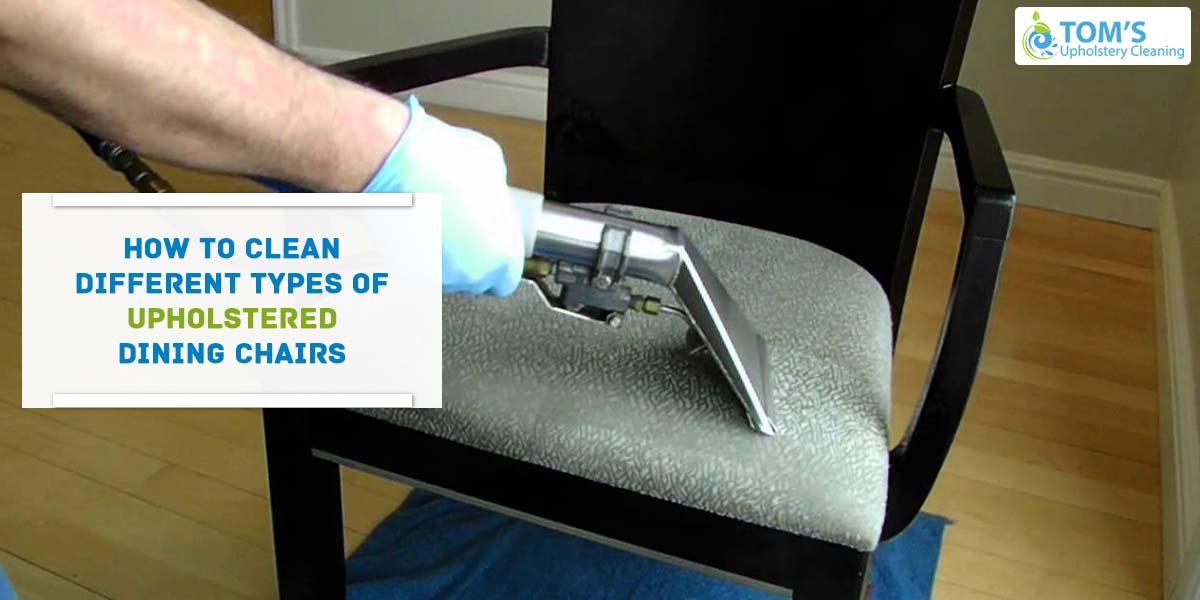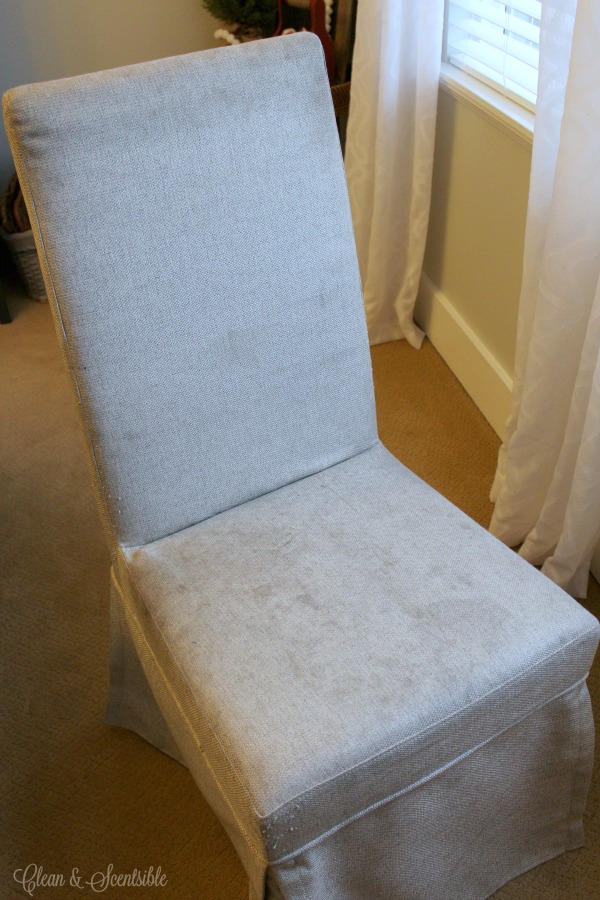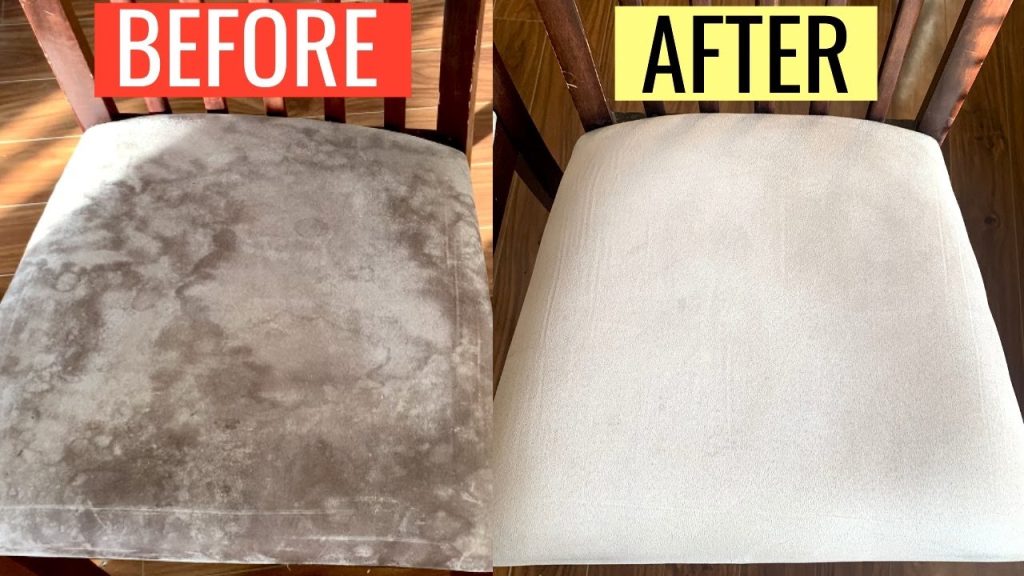To clean material chairs, vacuum the fabric first, then use a suitable upholstery cleaner. Dab stains directly with a mild detergent solution and a soft cloth.
Maintaining the pristine appearance of material chairs ensures not only cleanliness but also extends their lifespan, contributing to a pleasant and hygienic ambiance in any space. These essential pieces of furniture often accumulate dust and debris, necessitating regular upkeep. Users seeking to refresh their chairs will find that routine cleaning not only tackles dirt but also preserves the fabric’s integrity.
Addressing spills quickly and using appropriate cleaning agents can prevent long-term damage, keeping the chairs looking and feeling fresh. A well-cared-for material chair can harmoniously blend with your décor, making it a comfortable and inviting part of your environment.
Introduction To Chair Cleaning
Clean chairs not only look great but are also vital for good hygiene and longevity. Whether it’s a cozy fabric armchair or a sleek leather office seat, keeping chairs clean can make a world of difference.
Understanding The Importance Of Regular Chair Maintenance
Maintaining chairs regularly keeps them looking new and preserves their quality. Dirt and grime can damage materials over time.
- Dust accumulation can lead to fabric discoloration.
- Periodic cleaning avoids hard-to-remove stains.
- Prolongs chair life, making them a worthwhile investment.
- Ensures a clean and healthy environment.
Different Types Of Material Chairs And Their Cleaning Needs
Various materials have unique cleaning requirements. It’s important to know your chair’s material before you start.
| Material Type | Cleaning Method |
|---|---|
| Fabric | Vacuuming, spot cleaning, and steam cleaning |
| Leather | Wiping with a damp cloth, using a leather conditioner |
| Metal | Soapy water for cleaning, avoid harsh chemicals |
| Wood | Using wood cleaners, avoid soaking |
| Plastic | Simple wash with soapy water, use of soft brush for stains |
Identifying your chair type is the first step to a successful cleaning routine.
Preparing For The Clean: What You’ll Need
Starting with the right tools and environment is crucial for effective chair cleaning. A well-prepared clean-up ensures your material chairs look spotless and fresh. Let’s dive into the essentials you’ll need to get your chairs looking their best.
Essential Cleaning Supplies And Tools
Gather these supplies before tackling dirt and stains:
- Vacuum cleaner with an upholstery attachment
- Microfiber cloths for gentle yet effective cleaning
- Soft-bristle brush to loosen stubborn particles
- Mild detergent suitable for the material of your chairs
- Bucket for mixing cleaning solutions
- Distilled water, to avoid water spots from hard water
Creating A Safe And Effective Cleaning Environment
Set up a cleaning space that protects both you and your furniture:
- Choose a well-ventilated area to avoid inhaling fumes.
- Protect nearby surfaces with drop cloths or old towels.
- Keep pets and children away to ensure a safe space.
Assessing Your Material Chair
Assessing Your Material Chair is the first crucial step in maintaining its beauty and longevity.
Identifying The Material: Fabric, Leather, Or Synthetic
Chairs come wrapped in various materials, each demanding a unique approach for cleaning.
- Fabric chairs often feature a tag indicating the cleaning code.
- Leather chairs require products for their specific leather type for safe cleaning.
- Synthetic materials, like microfiber, may have manufacturer instructions online.
Spotting Signs Of Wear And Addressing Specific Issues
Every material exhibits wear differently. Timely identification helps in effective cleaning.
| Material Type | Signs of Wear | Cleaning Focus |
|---|---|---|
| Fabric | Fading, pilling | Gentle cycle vacuuming, spot cleaning |
| Leather | Cracks, dryness | Conditioning, protective creams |
| Synthetic | Stains, odors | Specialized cleaners, deodorizing |
Preparing to clean your material chair means knowing your chair’s material and understanding its wear signs. With this knowledge, you’re ready to move forward with confidence.

Credit: tomsupholsterycleaning.com.au
General Cleaning Techniques
Keeping material chairs clean is simple with the right approach. Regular care extends their life. It also keeps them looking fresh. Let’s dive into effective techniques.
Dusting And Vacuuming: The First Line Of Defense
Dust collects on chairs over time. Weekly dusting helps a lot. Use a soft cloth or a duster to gently remove surface dirt. Reach into crevices where dust hides.
Vacuuming is also crucial. Attach a brush to your vacuum. Gently run it over the chair’s surface. Pay special attention to seams. These areas trap dirt easily.
- Vacuum weekly for best results.
- Use low suction setting to avoid fabric damage.
- Change vacuum attachments for different chair parts.
Gentle Spot Cleaning: Tips And Tricks For Stain Removal
Stains are bound to happen. Act fast for better chances of removal. Blot spills with a clean, dry cloth. Don’t rub, as this pushes the stain deeper.
For a safe cleaning solution:
- Mix a teaspoon of dish soap with a cup of warm water.
- Dip a white cloth into the solution.
- Gently dab the stain.
- Rinse the area with a damp cloth.
- Pat dry with a clean towel.
Test the cleaner on an unseen chair part first. This ensures no damage or discoloration occurs. Use a white cloth to avoid color transfer.
For persistent stains, consider a fabric cleaner that suits your chair material. Always follow the manufacturer’s instructions.
Remember:
- Never over-wet the material.
- Avoid harsh chemicals.
- Spot test cleaners before use.
Following these guidelines helps maintain your chairs. They stay clean and vibrant for years to come.
Deep Cleaning Fabric Chairs
Fabric chairs add comfort and style to any room, but they can also collect dirt over time. Deep cleaning your fabric chairs not only keeps them looking great, it can also extend their life.
Follow these easy steps to give your chairs a thorough clean without damaging the fabric.
Choosing The Right Fabric Cleaner
Selecting an appropriate cleaner is crucial.
- Check the manufacturer’s label for cleaning codes.
- Use a water-based cleaner for W code fabrics.
- S code fabrics require a solvent-based cleaner.
- For WS or SW, either type is safe.
- Opt for mild detergents and spot test in an unseen area.
Step-by-step Guide To Shampooing Upholstery
- Vacuum the chair thoroughly to remove loose dirt.
- Mix the fabric cleaner with water if needed.
- Apply the cleaner to a soft cloth or sponge.
- Gently scrub the fabric in a circular motion.
- Blot out the excess moisture with a dry towel.
- If the chair is heavily soiled, consider using an upholstery shampooer.
- Fill the shampooer with the correct cleaner and water.
- Turn on the machine and slowly pass over the fabric.
- Be sure not to over-wet the chair to prevent damage.
- Allow the chair to air-dry completely before use.

Credit: www.homedit.com
Caring For Leather Chairs
Caring for leather chairs goes beyond simple dusting and spot cleaning. Leather, a durable yet sensitive material, demands dedicated attention. Proper upkeep not only cleans but also preserves the material. It maintains its supple texture and rich color. Keep reading to discover the most effective ways to clean and condition your leather chairs!
Effective Methods For Cleaning And Conditioning Leather
Regular cleaning and conditioning are keys to keeping leather chairs looking their best. Follow these steps to ensure your leather stays pristine:
- Dust the surface gently with a soft cloth.
- Vacuum crevices to remove any accumulated debris.
- Apply a water-based cleaner designed for leather. Use a soft, lint-free cloth.
- After cleaning, apply a quality leather conditioner. This maintains moisture levels in the leather.
- Allow the chair to air-dry in a room-temperature setting. Avoid direct sunlight and heat sources that can dry out the leather.
Preventing And Treating Leather Cracks And Fading
Environmental factors like sunlight and heat can damage leather over time. To protect your chairs:
- Position them away from windows or use window treatments to limit sun exposure.
- Maintain a consistent indoor temperature. Avoid placing chairs near heat sources.
For existing cracks and fading:
- Hydrate the leather with a specialized conditioner to restore flexibility.
- Consider a color-restoring cream if fading is significant. Choose one that matches your chair’s color.
Regular care prevents damage. It can save you from costly repairs down the line.
Maintaining Synthetic Chairs
Clean, stylish, and durable, synthetic chairs are a fantastic addition to any space. These chairs require special care to keep them looking their best. The right approach can ensure longevity and enhance appearance. Learn how to maintain synthetic materials with ease.
Synthetic Materials And The Best Cleaning Agents
Synthetic chairs often use materials like vinyl, polyester, or faux leather. Each material stands up well to daily use but needs specific cleaning agents.
- Mild dish soap and warm water work wonders on most synthetic fabrics.
- Use a soft cloth or sponge to avoid surface scratches.
- A mix of vinegar and water can revive dull surfaces.
- For greasy spots, baking soda offers a gentle cleaning solution.
Tactics For Tackling Tough Stains On Synthetic Surfaces
Stains stand no chance with the right approach. Here’s how to tackle them:
- Blot fresh spills immediately to prevent absorption.
- Apply a solution of soap and water, then gently rub.
- For ink or marker stains, isopropyl alcohol dabbed lightly lifts them away.
- For stubborn stains, a targeted upholstery cleaner designed for synthetic materials can be effective.
Rinse with clean water and dry with a soft towel to finish the process. Regular maintenance keeps synthetic chairs in prime condition for years to come.
Special Considerations For Delicate Materials
Cleaning material chairs with delicate fabrics needs extra care. Certain materials, like velvet and silk, are more fragile. They can get ruined if not handled properly.
Dealing With Sensitive Fabrics Like Velvet And Silk
Velvet and silk chairs look stunning, but cleaning requires a gentle touch. Use these steps:
- Vacuum with a soft brush attachment to remove dust.
- Blot spills immediately with a clean cloth.
- Test any cleaner on a hidden area first to check for colorfastness.
- Use cold water and a gentle detergent. Warm water can damage fibers.
- Dab gently at stains with a soft cloth. Never rub – it can push the stain deeper.
- Let it air-dry. Don’t use heat as it can shrink or damage the material.
Utilizing Professional Cleaning Services For High-end Chairs
Some chairs are too pricey to risk cleaning at home. Here’s when to call pros:
| Chair Value | Material | Why Professional? |
|---|---|---|
| High | Delicate | Pros have the right tools and skills |
| Very High | Rare | Avoid damage and maintain value |
Experts offer deep cleaning without hurting your chair. They have special equipment for every fabric type. Their experience means no guesswork and top care for your high-end chairs.
Drying And Post-cleaning Care
Cleaning material chairs is only half the battle. Proper drying and post-cleaning care are essential to maintain their look and longevity. This section will guide you through effective drying techniques to prevent mildew and discuss the use of protectants to preserve your chairs after cleaning. Let’s dive into ensuring your chairs are not just clean but also well-maintained.
Effective Drying Techniques To Avoid Mildew
Once your material chairs are clean, it’s important to dry them properly. Mildew thrives in moisture, making quick and thorough drying crucial. Follow these tips:
- Wipe excess water with a clean, dry towel.
- Place chairs in a well-ventilated area or outdoor space.
- If indoors, use a fan to circulate air around the chairs.
- Avoid direct sunlight which can fade colors.
- Confirm chairs are fully dry before use or storage.
Preservation After Cleaning: Protectant Sprays And Practices
After drying, your material chairs will benefit from additional protection. Here’s how:
- Choose a protectant spray suitable for the fabric type.
- Perform a spot test in an unseen area.
- Apply spray evenly, following product instructions.
- Consider reapplying protectant every few months.
In addition to sprays, use these practices:
- Avoid excessive exposure to sunlight.
- Vacuum regularly to prevent dirt build-up.
- Keep chairs dry and clean to extend their life.

Credit: www.cleanandscentsible.com
Preventive Measures And Daily Care
Fabric chairs add a cozy touch to any room, but they can easily collect dust and stains. Caring for them properly ensures they look their best and last longer. This guide dives into preventive measures and daily care to help you keep your material chairs spotless and inviting.
Implementing Routine Cleaning Habits
Dirt and dust can settle into the fabric of your chairs without regular care. To prevent this:
- Vacuum weekly using the upholstery attachment.
- Wipe down the frame and legs with a soft, damp cloth.
- Spot-clean spills immediately to prevent stains.
- Use a gentle fabric cleaner for deeper cleans.
| Frequency | Activity |
|---|---|
| Weekly | Vacuuming |
| Monthly | Gentle Fabric Cleaning |
Avoid harsh chemicals that can damage the fabric.
Protective Practices To Extend The Life Of Your Chair
To keep your chairs in prime condition, consider these tips:
- Avoid direct sunlight to prevent fading.
- Place chairs away from high-traffic areas.
- Throw blankets or slipcovers can protect the fabric.
- Rotate the cushions regularly for even wear.
Remember, prevention is key. Use coasters for drinks and train pets to stay off the furniture.
Conclusion: Enjoying Your Freshly Cleaned Chairs
Now that you’ve followed the steps to clean your material chairs, they stand renewed, enhancing your space with newfound freshness. Let the charm of your freshly cleaned chairs set a tone of cleanliness and order in your room. With every stain and speck of dirt removed, your chairs not only look better but also contribute to a healthier living environment. Sit back, relax, and relish the comfort of your spotless furniture. Let’s take some time to appreciate how these clean and inviting chairs make a difference in your daily life.
Reflecting On The Benefits Of A Clean And Inviting Space
- Improved air quality: Clean chairs mean less dust and allergens.
- Enhanced room aesthetics: Spotless chairs visually lift your space.
- Longer furniture life: Regular cleaning prolongs chair durability.
A clean chair can transform a dull space into a vibrant one. It not only looks good but feels good too. Your efforts in maintaining cleanliness pay off by providing a more pleasant living area. This positively influences your mood every day. Cleaning has long-term benefits that go beyond just aesthetics.
Planning Your Next Cleaning Cycle
Keeping your chairs in pristine condition requires a regular cleaning schedule. Here’s how to stay on top of it:
- Determine the frequency of cleaning based on use and exposure.
- Mark your calendar for your next cleaning session.
- Gather cleaning supplies ahead of time to avoid any delays.
Giving attention to your chairs ensures they remain inviting for years to come. Embrace the routine; it grants peace of mind, knowing your furnishings are always guest-ready. So, enjoy your refreshed chairs today, and look forward to keeping them splendid with your next cleaning cycle!
Frequently Asked Questions Of How To Clean Material Chairs
How Do You Clean A Fabric Chair?
Vacuum the chair to remove loose dust. Spot clean stains with a gentle fabric cleaner and soft cloth. Rinse with a damp cloth, avoiding saturation. Let the chair air-dry completely. Repeat if necessary for stubborn stains.
How Do You Get Tough Stains Out Of Fabric Chairs?
Begin by blotting the stain with a clean cloth to remove excess liquid. Mix a solution of mild soap and water, apply to the stain, and gently scrub. Rinse with a damp cloth and dry with a towel. For stubborn stains, use a specialized upholstery cleaner following the product’s instructions.
How Do You Deep Clean A Fabric Dining Chair?
Begin by vacuuming the chair to remove loose dirt. Treat stains with a mix of dish soap and water, dabbing gently. Use an upholstery attachment and steam cleaner for a thorough cleanse. Dry with a microfiber cloth and let it air-dry completely.
What Is The Best Cleaner For Fabric Office Chairs?
The best cleaner for fabric office chairs is a gentle upholstery cleaner formulated for fabric materials, ensuring it lifts stains without damaging fibers. Always spot test first.
Conclusion
Caring for material chairs need not be daunting. Follow the steps outlined for refreshed, durable seating. Regular maintenance preserves fabric integrity and aesthetic. For further upholstery tips, revisit our insights and sustain your furniture’s allure. Happy cleaning and enjoy your renewed space!

